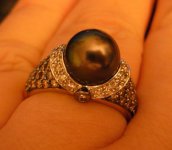Silvers, blues, creams, and yellows all occur naturally.
Regarding the bleaching of pearls with a pink overtone, you have to first understand the process that all of the pearls are going though.
A factory buys pearls from a farmer or several farmers. This is done in an auction event in Japan called hama-age nyusatsu, and most pearls are separated into what is called 1st grade and 2nd grade. In China harvests are negotiated individually. In either scenario the pearls make their way to the factories.
The factories wash the pearls and start processing them in the first treatment called maeshori. It is a Japanese word that means pre-processing. This is done before bleaching, and is nearly universal. From here the pearls go into the bleaching process. They are somewhat separated before this process by quality and color. This semi-separation is only to determine how long the pearls will need to be bleached. They are all bleached, but some for only a short period of time.
After the bleach comes the pinking, then the polishing, and finally the true separation.
The last step is where the pearls really get examined. This is where separation truly occurs. A few pearls may be pulled out at some point throughout the process, but not any real volume. Basically, everything goes through the same process.
It would not make a lot of sense to the factory to pull pearls that exhibit a natural rose overtone. Pinking is not a treatment that has until recently required disclosure. It is considered as universal as bleaching.
South Sea pearls can and do go through some treatments. If the pearls have gone though Japan, they are most likely maeshori treated and possibly color treated. These strands may have a tag that says "Product of Japan", as they must have this tag when exported. But you will not likely see this tag remain on a consumer level except on akoya (for deceptive reason we have openly discussed in the past).
It used to be that if the pearls came from Australia this meant no treatments had been done, but now this is only something guaranteed by the largest producer, Paspaley.
Tahitian pearls are often treated as well. From what I know this is not done in French Polynesia, nor is it done in the Cook Islands to Cook Island pearls. But low-grade Tahitians are routinely coated with polymer in Asia. Color enhancements are done as well. Unfortunately these treatments are rarely disclosed. The only way to be certain the pearls are not treated is to deal with a factory that you know well and trust, or to match and drill your own Tahitian pearls.
Chocolate Tahitians are a good example of treated Tahitians. The true chocolates are bleached, and the knock-offs are dyed.

